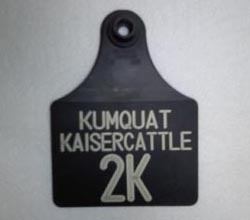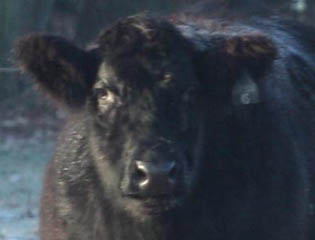The Red Cow: Cows with Names
By: Lana Kaiser Date: 04/3/2012 Category: | Animal Agriculture |
If you talk to a dozen cattlemen*, each will have a different way to identify and name their cows. Most of us, particularly if we have registered cattle, use the International year/letter code designation. Every year is assigned a letter (2012 is the "Z" year) and we run through the alphabet in the "usual fashion (A, B, C, D, E, F, G...) except we skip I, O, Q and V).
 Naming cattle: even more complicated than it sounds! Naming cattle: even more complicated than it sounds! |
So for registered cows (these would be cows of a specific breed, registered with the breed association) they will have a number (given by the farmer), the letter of the year, and for some breeds the "herd prefix" - which is a group of letters and sometimes numbers that identifies your herd from other herds of the same breed. These letters and numbers are tattooed into the cows ear as a form of permanent identification, and may be put on the ear tag . Every farm does their ear tags and their identification just a little different. So for my Kumquat cow her tag says "KUMQUAT; KAISERCATTLE; 2K" - that tells me she was the 2nd calf born in the K year (2000) and she is 12 years old. Her tattoo is 2K XX (2 is her herd number, K is the letter of the year, and XX is my herd prefix).
One way to identify calves is to use the dam's (mother's) number and the letter of the year. So if the dam is 247C, her first calf would be 247E, second calf 247F etc. Now to me that gets a little hairy, if she has all heifers, so you need a secondary way to identify the heifer's calves - so 247FH for 247F's first calf or should it be 247F1. I am already confused and for those of us who transpose letters and numbers that system just isn't going to work.
Another way to name or identify cows is to use the first letter of the cow's name to name all her calves - so the cow Mary would have calves Miranda, May, Marvin etc (so you would have the M family - a letter unrelated to the letter of the year). Another way to identify cows is to use the "cow family" philosophy: let's say we have the "Charm" family - you could do "Lucky Charm," "Golden Charm," "Charm bracelet," etc., or you can combine the sire (father) and the dam's name - so if the sire is Hobo and the dam is Charm you might have Hobo's Charm. And finally you can name all the heifer (female) calves after their dam and just change the number - so you would have Princess 121Z, Princess 214Z, Princess 345Z etc and the same for bull (male) calves - Fred 1961A, Fred 2143A etc.
Again, for those of us who transpose letters and numbers this doesn't work well - but for those who sell a lot of bulls sired by several different bulls naming the offspring after the sire and giving them a number with the letter of the year is an easy way to trace the pedigrees. In general the letter of the year and the number of the calf would be in the tattoo and on the registration paper.
Lots of letters and numbers do nothing but confuse me - so I tried to come up with an easy way to identify, name and age my cows. I like to name them after the letter of the year and also keep them with in the "cow family" - with good letters, this is easy, but there are some "bad" letters to name cows - U and X are particularly bad, and Y is not so great! So for example my very favorite cow, the lovely Sunflower, was born in the S year - 2006. I can count on my fingers (isn't that pathetic?) and tell you she is 6 years old (T,U,W,X,Y,Z). She the foundation dam of the "Flower" family - so her heifer calves were named Wild Flower (born in 2009, the W year), Xtra Flower (born in 2010 the X year), Yellow Flower (born in 2011 the Y year) and this years calf is Zinnia born in 2012 the Z year. You can see how one has to stretch the imagination for X and Y. Whether Zinnia's official name becomes Zinnia Flower remains to be seen - but when I saw her I knew she was a Zinnia.
 Registered cows: where a farmer may get to know her cattle better than some of the people in her life. Registered cows: where a farmer may get to know her cattle better than some of the people in her life. |
We also have the Violet family - her official name is Ultra Violet (the dreaded U year), her fist calf was Xtra Violet (whose first calf was Ziva's Violet), and her twin heifers were Yet another Violet and Yes she's Violet - basically I call all the Violets Violet, except for Ziva's Violet who is Ziva. Then we have another flower family, Snap Dragon, Upsy Daisy, Wild Irish Rose, Xavier Gardenia, Xavier Petunia and the "famous fruit family" Kumquat, Mango, Papaya, Sweet Pea, Sprout. Some cows tell you their name but sometimes the cows "official name" doesn't really fit her so it is either abbreviated or she is given (what the dog people call the every day name) - a "call name". So Upsy Daisy is "Red", Marmalade Plum is Plum, Xavier Gardenia is Gardenia, Ultramarine is Blue (yes she is a blue cow) , Xtra Sweet Pea is Tanky etc. Although right now I don't have any cow whose number is really their name, some cows name is their number and when "Good old 605" is mentioned it is with great affection.
Each calf is given a number to correspond with the sequence in which she is born - so Ziva is this years 1st calf and her number is Z1, followed by Z2, Z3 etc (or it could be 1Z, 2Z, 3Z - I told you I get confused). And each calf is given an ear tag with her number and the words "kaisercalf", getting an ear tag is like getting your ear pierced. It is important to be able to identify accurately each calf - if a calf is acting "punky" you need to know who it is - not just the "red calf", and down the road when you weigh and vaccinate and breed the heifers you have to keep accurate records so you know who got what and who is bred to who.
One of the big differences between having cows and raising calves (either registered herd or cow-calf herd) and the cattle in a feed yard (see Anne Burkholder's blog) is that in a feed yard the cattle are there for a finite period of time, and although you can recognize them as individuals there is really no long term relationship. With registered cows or cow-calf farms you may know some of your cows better and longer than some of the people you interact with. The ability to know and understand and communicate with an individual cow and her calf is one of the great joys of raising cattle - it is also one of the things that make if very difficult.
* Yup, despite the fact that "we've come a long way baby," and that women are intimately involved in many beef cattle farms and ranches, it's still "cattlemen."
About The Author
All Authors Of This Article: | Lana Kaiser |











